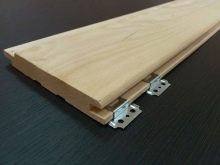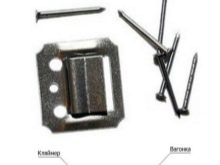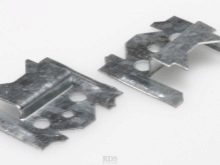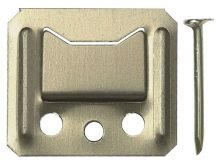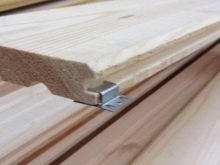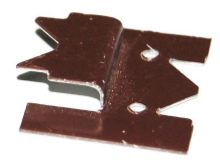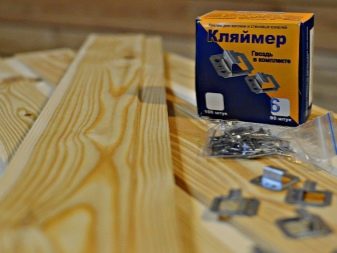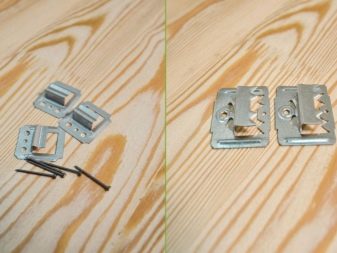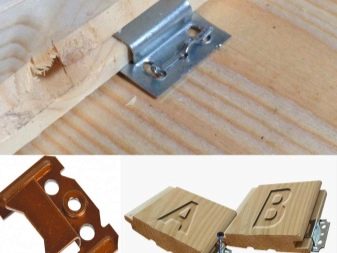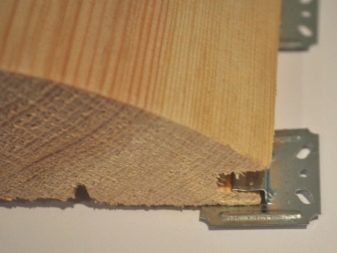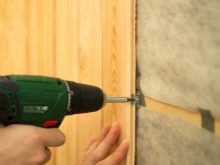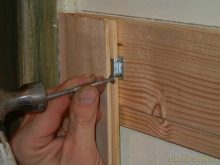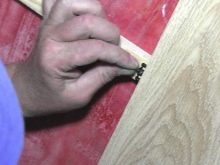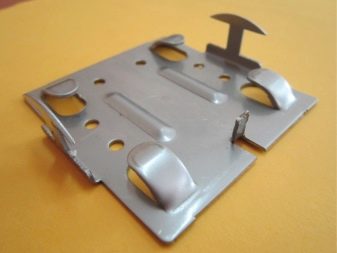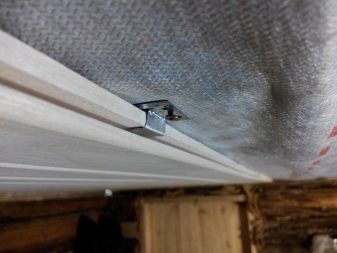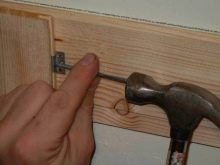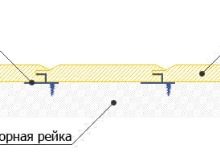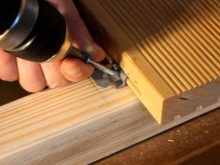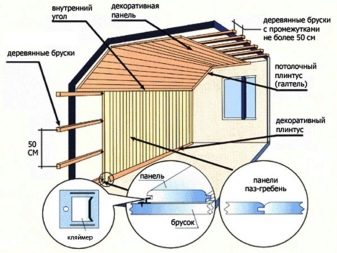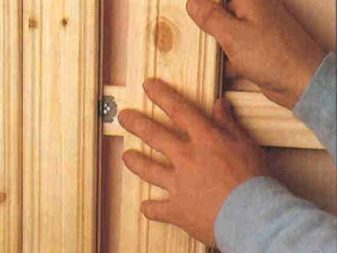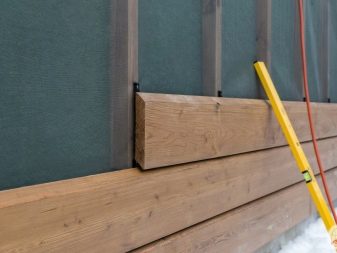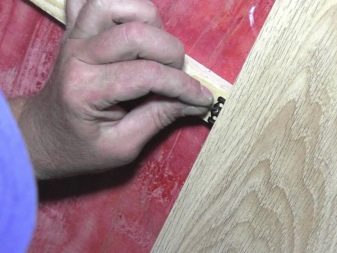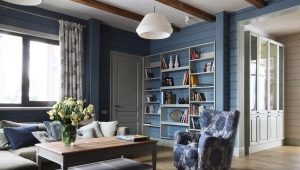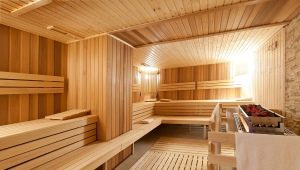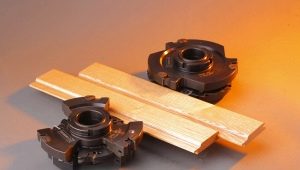Choosing klyymery for lining

Lining - a board made of high quality wood and special treatment, used in the construction and decoration of houses, has been widely spread throughout the world. One of its most popular types is called “Calm”. Previously, only screws, nails and screws that were visible were used to attach it. Recently, preference has been given to concealed installation elements, which significantly improved the appearance of the room and the possibilities of their design.
Klyymery as a kind of hidden mount lining
Klyaymery - this is one of the options for mounting a hidden type of interior decoration. They are special braces, mounted on the surface of a wall or other base with the help of ordinary screws, as well as nails.A protrusion hook of a special shape, available on the Klyimer, serves to further fasten panels to it.
They are used for fastening different materials.
- Hinged elements of facades made of stone or tile up to 14 mm thick. For the installation of natural stones make reinforced products, designed for thickness up to 40 mm.
- Cladding facades with large elements of aluminum.
- Elements of flooring, such as decking.
- Skirting panels.
- Different panels having different sizes inside the building.
- Clapboards of the most various profiles and from various materials.
Klyaymery are made on special equipment by stamping from ordinary and special strip steel, as well as from aluminum. After that, they are coated with an anti-corrosion coating, most often zinc.
The use of klyaymerov for installation has a number of specific advantages and advantages.
- There is absolutely no possibility of damage to the material of the panels when they are mounted. This is due to the fact that there are no holes when using them. While when fixing the lining panels with nails and self-tapping screws, there are always openings, from which further cracks can later form, moisture can get into them and cause rotting of the material.
- Klyaymery are hidden fasteners that are not visible from the outside. This improves the appearance of the room, and the walls look beautiful and stylish, as a whole, without nail caps, as well as screws.
- This is a very easy-to-use type of installation that does not require special tools.
- Durable metal staple is very reliable and serves for many years.
When choosing klyaymerov should consider that they are available in various thicknessesWhich choose, considering weight of the fixed designs. So, the usual, most common, has a thickness of about 0.5 mm, and the reinforced version is about 1 mm and more. If you are going to use Klyimer for fastening, it should be noted that in this case the fastened panels must have a margin of clearance thickness, calculated taking into account the thickness of the fastener used. Otherwise, it will not be used.
To do this, you need to take the panels from different packs, insert them into each other along with the clearer. In this case, everything should go tightly, without unnecessary gaps, otherwise the installation configuration will change.
Basic rules for the selection of klyaymerov for lining
Depending on the thickness and weight of the material used, different types of clamps are used.So, for thicker and massive lining choose klyimery made of thicker and more durable metal. Klyaymery pick up and depending on the size and materials used. The metal brackets themselves differ in the size of the special projections on which the lining sheet is supported.
Available in various types of klyaymerov.
- For mounting chipboard. The thickness of the material for the manufacture of 4 mm.
- For lining from plastic and MDF. Given the low weight of the material, the thickness of the elements of Klyimer is used up to 2 mm.
- For the implementation of the installation of panels eurolining. It uses staples with a thickness of 4 mm.
- Reinforced, for fixing classic wooden wall paneling, up to 5 mm thick.
When choosing the brand it is necessary to consider that their use:
- considerably increases the speed and productivity at installation and connection of panels of lining;
- material damage, including the formation of cracks, is completely excluded;
- the quality of work and fixing of the panels is not affected by high humidity and temperature;
- provides a strong fastening of the panels, which over time will not loosen and bend;
- they have low cost with high and accurate workmanship;
- fastener is invisible, which significantly improves the appearance of the resulting surface.
In addition to the usual options by the method of stamping, kleimery with spikes on the surface. Their use can significantly increase adhesion to the surface and reduce the risk of lateral displacement.
Klyaymery applied should securely fasten the panel in a well-defined location and position on the wall. Their number depends on the total length of the fixed wall panel and the material from which it is made.
Rules for calculating the markers and their use when attaching
Experience using klyaymerov shows that for reliable and durable fastening of one square meter is enough to pick up about ten pieces.
- For a more accurate calculation, it is necessary to measure the length of one panel. After that, we measure the pitch of the crate frame. Usually this distance ranges from 40 to 60 centimeters. We divide the length of the panel by the step of the batten and add one. Multiply the result by the number of panels. This will be the right amount for mounting.
- When choosing the type of product to be used for fastening the panels, it is necessary to take into account that each element should be mounted with two or three self-tapping screws. Save on their number is not worth it, as this may affect the reliability and quality of installation in general. Thicker reinforced elements with a large number of points of their attachment are used for fastening heavy panels.
- After calculating the number of adhesive, you can begin to install the panels. The wall on which the installation is planned is pretreated with special antiseptic solutions to eliminate the possibility of fungus formation. Subsequently, the clamps are installed on the wall or the installed crate with nails or screws. In this case, the nails are used only in the case of application of crates.
- Since the use of lining requires a flat surface, then in the presence of uneven walls should be calculated how best to align them. Perhaps, leveling the surface of the wall with a special solution or installing crates.
- Very often, in such cases, a crate is used, which is installed on the wall surface quickly, and it can be immediately installed.Usually the crate is made of a wooden bar of the same thickness, which is fixed at a distance of about one meter from each other. When installing wooden lining this distance is somewhat less, and is about 50-60 cm.
- When installing the crate, you need to constantly control the plane of the resulting surface, which should be flat. If necessary, to obtain a flat surface under the bars put a plate of the required thickness.
- The use of solutions for leveling takes a lot of time, after which it also takes time to dry them. Therefore, this option is used much less frequently and if necessary, such work.
- Having installed the fasteners for the first panel, they proceed to its installation and the subsequent fastening of the clamps for the next one. The first board is tightly inserted into the hooks of the clears, the rest are mounted the same way. This method provides an accurate and reliable fit of each panel to each other.
- To ensure quality installation with further natural ventilation, it is necessary to take into account that boards should not touch the surface of the wall.Otherwise it will lead to limited ventilation, moisture accumulation, mold and mildew.
- When working with clapboard and clamps, it should be noted that work should be carried out at an ambient air temperature of at least 10 degrees, since at lower temperatures the panels can be deformed. Klyymery should be made of stainless materials and treated with a special protective coating, as rust can spread on the surface of the wall paneling.
- At the joints of wooden panels can not use liquid sealant, and it is better to choose for this moisture-proof film. Its use at temperature drops may lead to cracking of the panels. After installation, the surface of the lining should be treated with special protective antiseptic materials that increase its resistance to precipitation and ultraviolet radiation.
- Taking into account all requirements for the selection of clamps for lining will provide reliable and durable installation, as well as a long service life of the installed coating.
See how to fix the clapboard for clapboard in the next video.
